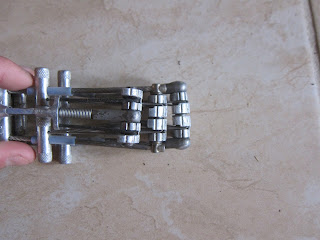Happy Rocktober, everyone. I hope it went well. October seems to be excellent for rock climbing in most places in the country. From Yosemite to the desert Southwest, to the Northeast and Southeast, it seems like everyone is out craggin' in Rocktober. Heck yes.
This past weekend, I found myself going through all my rock climbing gear to clean, sort, and decide what's still good for use. As I did this, I realized that I have three generations of one particular cam - the trusty #1 "Blue" Metolius. Ol' Blue has fit into more little tips cracks than I can remember, and held more falls than I'd like to admit. It's a workhorse, to be sure. But what caught my attention, placing all three generations side by side, is the evolution of cam design. I don't have all the generations of the Metolius cams, but here are the three I do have:
-Three generations of #1 Metolius Cams. The top two are older and the newest generations of Powercams and the bottom is the newest generation of Mastercam.
You can see the design changes between #1 (top. Older generation Powercam), #2 (middle, newest generation of Powercam)
and #3 (bottom, new Mastercam). Specifically, the overall structure of the stem of the Mastercams - width and length - got smaller in the newer generation, probably to save weight. They feel fine to use, though, no loss in utility. Also, the new generations sport a Dyneema/nylon sling, also pretty cool.
What is another cool thing is the change between Powercams to Mastercams, which drastically reduced the head size. See the picture below:
-Powercams on the right, new Mastercam on left.
This is what makes the new generation of Mastercams so cool. The reduced head size allows the cam to fit into smaller pockets. Its longer stem helps it to feel a bit better in hand. This next picture is a side-by-side of the Mastercam and Powercam
-Powercam on left, Mastercam on right.
Also, the Mastercams have narrower lobes. The Powercams have wider lobes, which have more surface area contact with the rock itself. In strong rock like granite it's not so important. But in soft rock like the sandstone we all know and love, surface contact is a big deal. I don't know the specifics about the Mastercams in sandstone. I've climbed on them - and fallen on them - in sandstone, but it does makes you wonder. We often do not use TCUs (three cam units, as opposed to the typical 4CU) in soft rock because of the lower surface area. Metolius even makes a wide-lobed cam specifically for soft rock, called the
Fat Cam, which is, I'll admit, pretty confidence-inspiring when sending the project at Indian Creek.
Yep, you can call me a nerd for geekin’ out on cams, but hey, I use
them a lot, and I think it's pretty cool. As I look at these generations of
cams, I think about other cam designs (Metolius Fat Cams, TCUs, & offset TCUs, Black Diamond C3's, Aliens, etc.), and the *newest* cam to come out (Spring 2013) - the
Black Diamond X4. This one's pretty cool, it's worth checking out. It seems like an Alien look-alike, but with Black Diamond's attention to detail, design, and, oh yeah, safety. CCH Aliens are a staple, especially among hard rock climbers and wall rats, but they're notorious for breaking. Yeah, major bummer. So the X4's look particularly cool, and I'm excited to try them out when they come out in the Spring.
Until then, go out and use those cams while the weather lasts!
--Mike Pond, Instructor and Guide




No comments:
Post a Comment